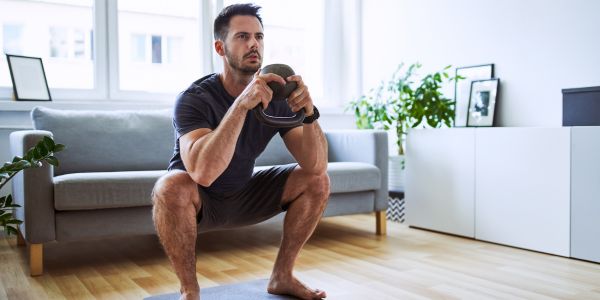You don’t feel it now, but ten years from today, your back will. Your knees will, too. Your grip, your spine, and your balance will all be affected. That’s because strength isn’t built by what looks cool on TikTok.
So, let’s talk about 5 simple exercises that will silently bulletproof your body if you start doing them now. Stay tuned; I bet you’ll love number 3.
But first, if there’s one position your joints were built for but forgot, it’s the deep resting squat. I’m not talking about the weighted kind at the gym, but rather the bodyweight kind your ancestors used to eat, rest, and work in. Most of us lost that ability by the time we were teens. Chairs, long commutes, and 10 hours sitting at desks slowly erased it.
That’s why 65 million Americans complain of back pain, 15% of US adults have neck pain, and many more have hip mobility issues. I won’t even get into the costs you’re facing to fix all this.
But when you drop into a full squat and just sit there, you’re unlocking a range of motion across your ankles, knees, hips, and spine. You’re training posture, balance, and core control without even realizing it. Even better, your muscles stay active as well. Your quads and glutes stabilize you, hamstrings and adductors control your descent, and the spinal erectors hold you upright. Even your ankle muscles fire to keep your feet grounded.
The benefits go way beyond mobility. In cultures where people still rest like this daily, rates of knee surgery, hip replacements, and back pain are way lower. There’s even anthropological data showing early humans spent up to three to five hours a day in this position and didn’t suffer the same age-related joint issues we see now. Our bodies are wired for it.
Now, it may seem hard at first, but follow my tweaks and you’ll nail it. First, if your back rounds too much, elevate your heels. And if your hips feel tight, push your knees out with your elbows. You can even reach your arms up while holding to open your upper back.
Now, the next exercise is as old-school as it gets. You’ll just pick something heavy and walk. Yes, I’m talking about Farmers’ carries, which train grip strength, core stability, postural endurance, and full-body coordination. You’re basically teaching your body how to hold itself together under stress, which is exactly what breaks down first as you age.
When you carry heavy loads at your sides, everything from your forearms to your lats, glutes, and obliques has to work to keep you balanced and upright. Your ribs stay locked down, your glutes stay tight, and your core fires the entire time like you’re walking in a wind tunnel.
Remember to focus on control, though. If the weight pulls you off-center even a little, you’re losing the point.
If you want to train your core even more, go single-arm. This is called a suitcase carry, and it forces your obliques to resist rotation.
Here’s what I recommend if you’re just getting started. Instead of counting time or reps, set a fixed path. Forty meters is a good start. That way, your brain doesn’t cheat with a countdown: you either make it or you don’t. And when you do this consistently, your posture, your grip, even your breathing under tension all get sharper.
Ignore farmer’s carries now, and ten years later, it’s not your biceps you’ll miss. It’ll be your ability to stay upright under load without feeling it in your back.
And here’s a good one I wish more people would start doing. It’s genuinely one of the few movements that trains power, mobility, and endurance in a single rep. It teaches your body to explode, reset, and control force all in one smooth pattern. And that’s exactly what fades first with age, meaning your ability to generate power quickly.
Can you guess what I’m talking about?
It’s the clean and press.
When you clean the weight from the ground, it’s your hips, hamstrings, glutes, and traps doing the work. Remember that you’re not curling it. You should be driving it up with leg power, catching it at your shoulders. Then comes the press. Now your delts, triceps, and upper chest take over, pushing the weight overhead while your core braces and your spine stabilizes. It’s one continuous chain of movement that leaves nothing out.
What makes clean-and-press essential is that it trains speed and precision under fatigue. You’re lifting moderately heavy, plus you’re doing it fast, with control. This move keeps your fast-twitch fibers alive, the ones responsible for quick reactions, balance corrections, and fall prevention. Once those go, recovery gets slower, injuries get more likely, and strength becomes harder to rebuild. And I will remind you that over 14 million Americans over the age of 65 fall each year. That’s definitely something you want to avoid.
Now, here’s something I’ll bet you’ll struggle with. Most people butcher the clean by turning it into a slow curl. That kills the point. You want to hinge back, drive with your hips, keep the bar close, and catch it clean on your shoulders with your elbows high, core tight. From there, press smoothly, keeping your ribs down so you don’t arch your lower back.
Next, let’s get into a more mellow exercise.
Walking backwards looks like a joke until you realize physical therapists actually recommend it for knee pain. This move retrains neglected muscles in your knees and reinforces joint mechanics that most people lose without realizing it.
I’m gonna tell you exactly how this works.
When you walk backwards, you’re forcing your quads, particularly the , the teardrop-shaped muscle near your knee, to activate more than it would in normal walking. That muscle plays a key role in stabilizing the kneecap. It’s also one of the first to weaken with age or injury, especially after sitting for years, but walking or even pedalling backwards strengthen it.
You’ll also be sharpening your coordination. Because walking backwards removes visual feedback, your brain has to rely more on proprioception, which is your body’s sense of position and balance. That kind of feedback loop is exactly what deteriorates with age and increases fall risk.
There’s research behind it too. Reverse walking, especially on an incline or with light resistance, has been shown to reduce knee pain, improve gait in elderly adults, and even improve performance in athletes. Some rehab protocols now use it to fix chronic knee issues because it trains the posterior chain and rebalances movement patterns.
Now, I wanna tell you about an exercise I can’t live without.
Dead hangs are one of the most honest tests of shoulder health and grip strength you can do. You can’t believe how many people say this exercise helped them with shoulder impingement, back pain, and a slew of other health issues. The moment you grab the bar and let your body drop, you’ll know exactly what I’m talking about.
The benefits start with decompression. Most people carry years of spinal compression from sitting, lifting, and bad posture. Hanging lets your spine stretch naturally, taking pressure off the discs and realigning your upper body. You’ll feel it in your lats, your traps, and especially your shoulders. That stretch is teaching your shoulder joints to open up and your rotator cuffs to stabilize. This matters because shoulder impingement and cuff tears are some of the most common injuries in adults over 40, often from simple daily movements like reaching overhead.
Then there’s grip. Weak grip doesn’t just make lifts harder. It’s linked to overall strength, mobility, and even longevity. Lots of studies showed that lower grip strength correlates with a higher risk of heart disease and early death. It’s that foundational.
So, that’s it from me. If you made it this far, thank you. Seriously. You guys help keep this channel growing, and I don’t take that for granted.
Now I want to hear from you. Which of these five exercises are you already doing? What better exercises did I miss?
- 5 Exercises You’ll Regret Ignoring in 10 Years - May 22, 2025

